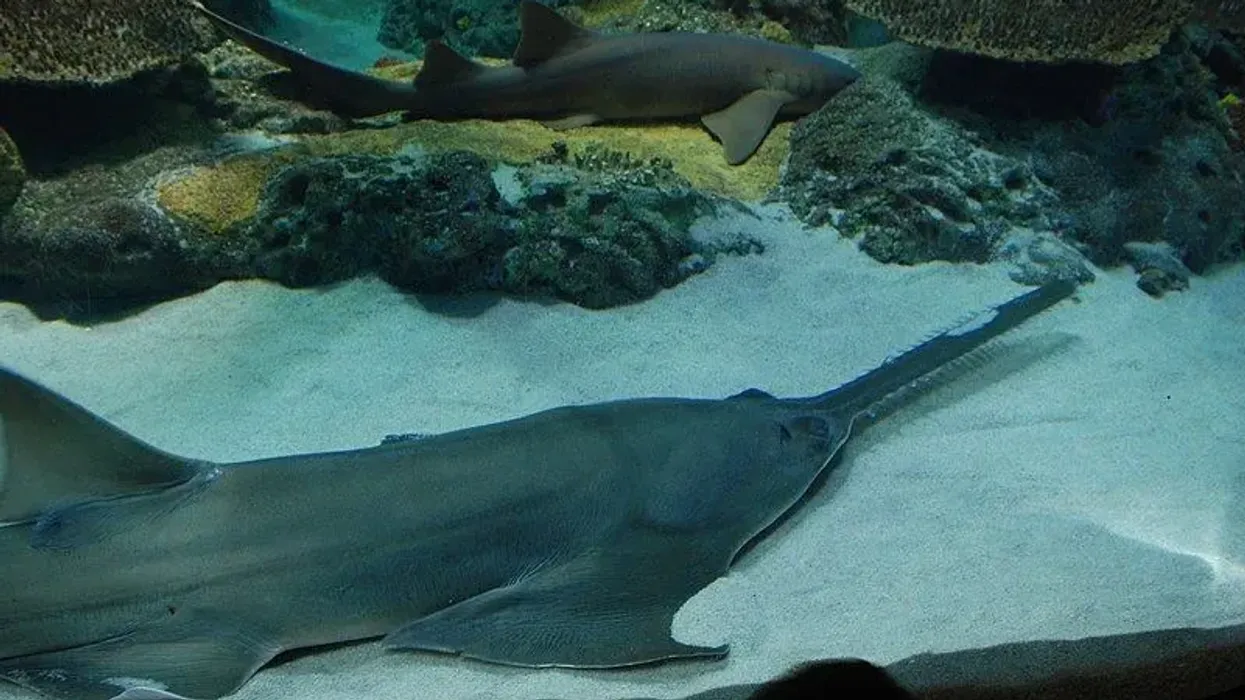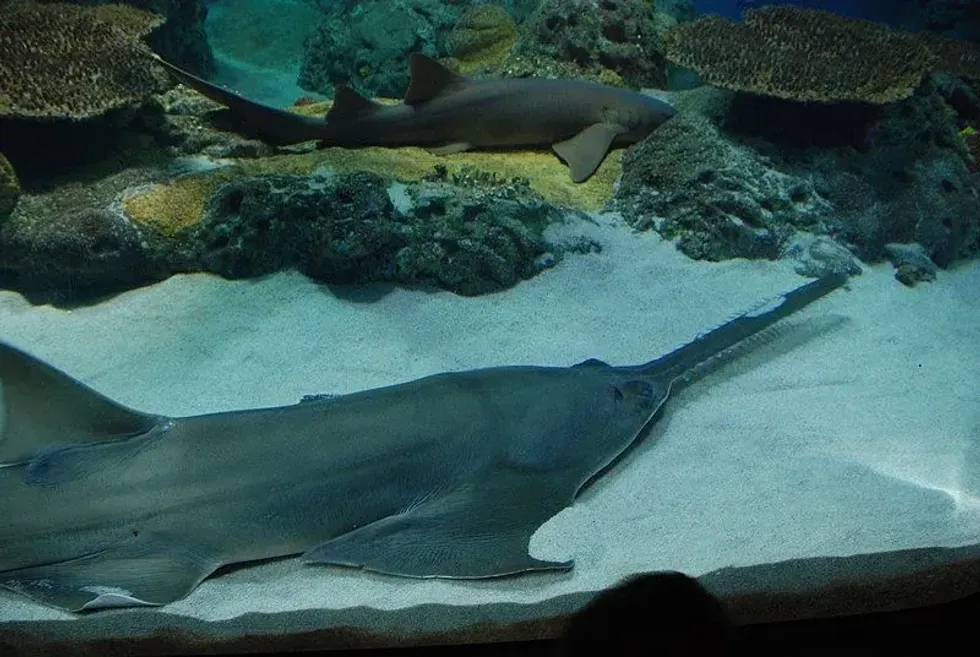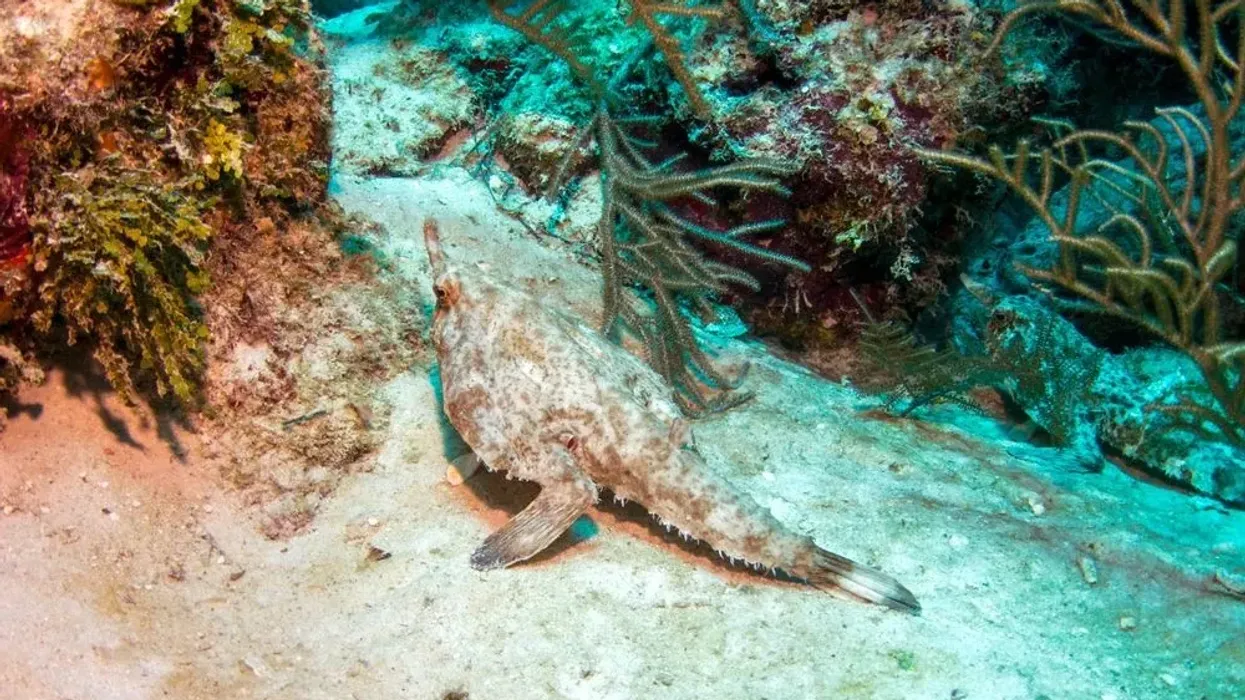There are a total of five species of sawfish living worldwide today namely, the smalltooth sawfish, largetooth sawfish, green sawfish, dwarf sawfish, and narrow tooth sawfish.
Smalltooth sawfish, Pristis pectinata, is classified as a critically endangered species and is found in tropical and subtropical regions of the world. Sawfish are protected by the Endangered Species Act in the U.S. hence it is illegal to catch, harras, or illegally smuggle this fish.
It has also been listed as an endangered species by the National Marine Fisheries Service under the Endangered Species Act.
Resembling a chainsaw the smalltooth sawfish, Pristis pectinata is a fish species with long snouts or rostrums and have sharp teeth sticking out around its edges. These species are related to sharks and rays.
They are largely gentle beings unless they are harmed in any way in which case they are sure to retaliate. If you liked this article, please take a look at largetooth sawfish and sawfish articles as well.
Smalltooth Sawfish Interesting Facts
What type of animal is a smalltooth sawfish?
Smalltooth sawfish, Pristis pectinata, is a type of fish and is a rare species that is almost on the verge of extinction if they are not protected.
What class of animal does a smalltooth sawfish belong to?
Smalltooth sawfish are a type of fish that belong to the Chondrichthyes class of species.
How many smalltooth sawfish are there in the world?
There are an estimated 5000 smalltooth sawfish, Pristis pectinata, left in the world and they are a critically endangered species. As of current statistics, there is a possibility that only 200 of them exist. Data gathered will aid conservation efforts and provide insights into their life, history, and other aspects of this species.
Where does a smalltooth sawfish live?
Initially, sawfishes were only found in any regularity in south Florida waters, in Florida Bay, and the Florida keys between the Caloosahatchee River and the Florida River but now the sawfish previously encountered in Florida waters have rarely been seen. Similarly, they were commonly encountered offshore from Texas to North Carolina.
It's been decades since one has been discovered post that. They are also seen in the Atlantic Ocean and the Caribbean Sea. Strict laws were passed after their status was declared as critically endangered.
What is a smalltooth sawfish's habitat?
Smalltooth sawfish live in coastal tropical and subtropical waters. Some other coastal habitats where these species are found include bays, lagoons, rivers, and in estuaries or brackish waters.
Adults are found in the same habitats for most of their life while juvenile sawfish use shallow highly vegetated habitats such as mangrove forests for critical habitat to save themselves from possible predators. Many of their habitats have been lost due to development and modification activities.
Who do smalltooth sawfish live with?
Smalltooth sawfish are largely seen alone in water bodies and are solitary beings however they coexist with other species of marine life and are careful to save themselves from possible predators.
How long does a smalltooth sawfish live?
The average lifespan of a smalltooth sawfish is 30 years. This often depends on various factors including their diet and their environment.
They are often seen feeding on schools of fish. The oldest recorded sawfish species were recorded from the remains of the Peyeria dating back to 100 million years old although the recorded species is more of a rhinid species than a sawfish.
How do they reproduce?
They attain sexual maturity at the age of ten years. The male inserts his claspers which are paired with the female's reproductive organ.
There is a possibility that females don't find a possible mate due to the lack of their population. Sawfish are ovoviviparous, meaning that the young ones grow as eggs inside the mother and after the embryos are fully developed the mother sawfish gives birth to young ones.
The young are immediately left once the mother gives birth to them and are expected to hunt and protect themselves. The young ones rely on mangrove forests for critical habitat during their juvenile years.
What is their conservation status?
Smalltooth sawfish are listed as critically endangered species by the International Union For Conservation Of Nature (IUCN). You can help sawfish conservation efforts by reporting your encounters with sawfish to recognized authorities. The wildlife population is deeply impacted by the pollution of water bodies.
Smalltooth Sawfish Fun Facts
What do smalltooth sawfish look like?

The smalltooth sawfish has a saw-like appearance. Smalltooth sawfish skin is different from sharks since its made up of tiny teeth-like structures called placoid scales also known as dermal denticles. Sawfish have long, flat rostrums or snouts.
They possess pectoral fins, pelvic fins, two dorsal fins, and a caudal fin. Smalltooth sawfish have a moderately developed caudal lobe and a well-developed upper lobe.
Male smalltooth sawfish possess an organ called claspers which are located in the inner region of their pelvic fins. Female smalltooth sawfish do not possess claspers. Males make use of claspers when they mate with females in order to reproduce.
How cute are they?
They are not exactly cute to look at but are majestic and unique in their appearance. This species of fish have a distinct shape and size which sets them apart from other species of animals. Information about them is available in the Florida Museum of Natural History located in Gainesville.
How do they communicate?
Smalltooth sawfish are not verbal like human beings and communicate via signals. They are capable of detecting electric signals which they make use of to find possible prey, predators as well as find possible mates. Given their population has been impacted greatly it's rare for them to find their own species unless they are kept in a conserved space.
How big is a smalltooth sawfish?
The smalltooth sawfish is 25ft (7.6m) in length which is ten times bigger than the smallest species of sawfish i.e. dwarf sawfish which is 10ft (3.1m).
How fast can a smalltooth sawfish swim?
Smalltooth sawfish are languid swimmers but once they detect possible prey they move relatively fast. Even when they detect predators they increase their speed to save themselves.
How much does a smalltooth sawfish weigh?
Smalltooth sawfish weigh 700lbs which is 317 kg. Some species of sawfish have the capacity to grow from 18 feet to 20 feet long. The International Sawfish Encounter Database maintains information about sawfish species and helps researchers find adequate information about the species. There also exists an International Sawfish Encounter Database Florida Museum of natural history about fish species.
What are their male and female names of the species?
Male and female are not addressed differently however, they have a different reproductive function. Male smalltooth sawfish possess organs called claspers which are located in the inner region of their pelvic fins. Female smalltooth sawfish do not possess claspers. Males make use of claspers when they mate with females in order to reproduce.
What would you call a baby smalltooth sawfish?
Baby smalltooth sawfish is referred to as an egg when it is inside its mother's womb. When they grow up and the mother gives birth to them they are referred to as pups until the age of ten when they attain sexual maturity and become adults.
The young ones rely on mangrove forests for their habitat during their juvenile years. The mangrove forests serve as nursery areas.
What do they eat?
These fish locate prey in the low visibility of coastal waters by sensing the electric field created by the currents in the water. After locating small fish, smalltooth sawfish shake their head from side to side to slash through the schools of fish.
This stuns and impales their prey. The smalltooth sawfish can use its jagged snout to great advantage to sense and capture its prey.
Are they dangerous?
Smalltooth sawfish don't pose a threat to humans as long as they are not troubled, they also don't kill humans. Fishing for smalltooth sawfish poses a threat to the species and is considered illegal in various places now.
The species is critically endangered due to the fishing pressure business. It is especially prone to capture in fishermen's nets throughout the twentieth century and even now.
Placing nets is enough to kill a sawfish as these fish have a strong propensity to get entangled in nets. The state of Florida bans the use of gill nets in state waters.
Would they make a good pet?
No, they are innately wild fish species and best thrive in their natural environment. Their population reduced from an estimated 5% of its former range and population and now occur only in a few places where fishing is banned or illegal.
If you wish to learn more about these species it's best to visit a natural history museum or a center where information about them is available.
Did you know...
If a sawfish chips a tooth while defending itself, or if its chompers get worn down, they don't panic since their teeth continue to grow throughout their life, which is an added advantage for sawfish that is not present in various other species of animals.
The rarity of seeing a sawfish in the wild prevented scientists from collecting conclusive evidence about the species. Scientists now want to know if you see a sawfish to gain an understanding of their behavior and other aspects of this species.
If you are one of those few people consider yourself lucky. If not, you could still study more about the species from resources available online.
What is the biggest sawfish ever caught?
The world's biggest sawfish ever recorded was a 16-foot female and washed up dead on the shores of Florida.
The female was pregnant when she was caught and had eggs inside her similar to the size of tennis balls. Another fish too was seen on the same day on the shore and both died an unfortunate death, however, the female was the biggest sawfish ever caught as per researchers.
The behavior of the sawfish is similar to that of a swordfish fish and hence this makes them easier to capture.
What is the difference between a sawfish and a saw shark?
Sawfish and saw sharks are often confused with each other however they are different species with distinct features. Sawfish have a long, flat rostrum or snout.
Sawfishes are a type of rays and have a gill opening on their ventral side while saw sharks have a gill opening on the side of their body. Saw sharks are smaller in size as compared to sawfish. Saw sharks reside in deeper water bodies while sawfish live in coastal waters and waters off the coast.
Here at Kidadl, we have carefully created lots of interesting family-friendly animal facts for everyone to discover! Learn more about some other fish including the moray eel and the blacktip reef shark.
You can even occupy yourself at home by drawing one of our smalltooth sawfish coloring pages.










